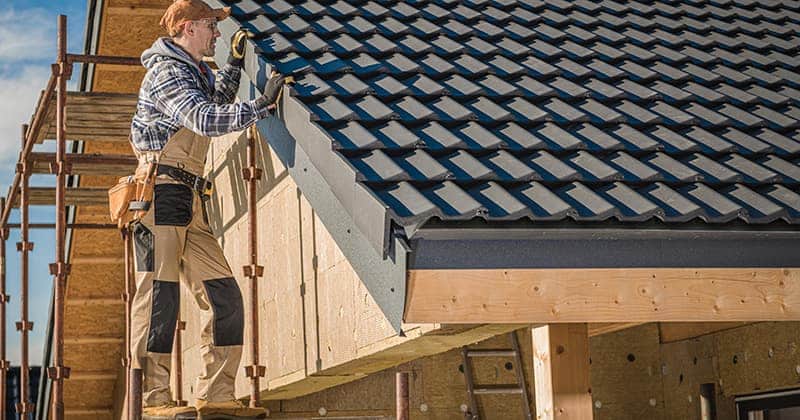A roofing contract is a vital legal document for any project. It defines the scope of your work. It helps prevent misunderstandings and provides legal protection if there are disputes.
With all the details outlined, everyone knows what to expect. Almost all your customers will expect a well-organized contract. The document protects them as much as it protects you.
A written contract may not be required by law. They are always a good idea, though. Almost every professional roofing company will rely on comprehensive written agreements.
However, the document does not automatically offer protection. The benefits are only upheld if you include the right information and details.
In this article, we’ll look at why you need a written roofing contract. How precisely does it benefit you as a professional? How can it offer protection to your clients?
You’ll learn about the elements and sections you need to include. Consistency throughout your contract makes using them from one job to the next easier. It also ensures you don’t miss anything important.
Ultimately, you’ll walk away with advice for creating strong roofing contracts that support your professional standards.
Why You Need a Roofing Contract
A roofing contract is a signed agreement between you and your customer. Its goal is to outline the scope of the work and the project details. The document also specifies the finished product you must deliver.
A contract defines every facet of the project. The details should include the materials used and the timeline. It also covers the steps for the project and the methods used.
A good contract mentions how to handle unforeseen circumstances as well. For instance, the agreement may detail how to use change orders to alter contract details.
The contract often extends beyond the completion of the project. It can include warranties for work and products used. Usually, it details the steps you must take to fix any problems that occur during the warranty period.
Contracts are legally binding. You or the client can take legal action if the other party fails to meet the requirements.
For you, this might mean the client fails to pay after the project. Or they refuse to pay until you complete work not outlined in the contract.
For the client, it means not paying until the work is complete to the contracted specifications.
Benefits of Roofing Contracts for Companies and Customers
Here is a closer look at the reasons you should have a detailed roofing contract for every project:
- It ensures you get paid. The contract gives you legal options if the customer does not pay on time. It also provides clear timing and instructions for payment.
- It reduces liability. A contract ensures you aren’t responsible for problems outside the project scope.
- It sets clear expectations. Clients know what they will get at the project’s end. This limits the risk that they will demand additional work after you complete the project.
- It protects your reputation. You can prove that you delivered the job on time and met quality standards. Contract details are useful when responding to unreasonable clients. It can also serve as a rebuttal for poor reviews.
Contracts also allow you to establish yourself as a professional roofer. A detailed written contract signifies organization, dependability, and professionalism. It sets you apart from companies who rely on handshake agreements and vague plans.
RELATED ARTICLE: Severe Weather Roofing: Best Practices for Roofing Companies
Customers benefit from a detailed contract, too. Here are the advantages the document brings to them:
- It sets deadlines. Customers will know when each stage of the work should be completed. In other words, it protects against lengthy projects or extended delays.
- It provides guarantees. The agreement outlines work quality requirements and warranties on labor and products. It gives customers ways to address subpar work or poor-quality materials.
- It ensures compliance. The contract includes permits and other legal requirements. These items verify that the roof complies with all local building requirements and laws. This is important for customer records for any future questions or insurance disputes.
- It locks in the price. Unforeseen circumstances, such as the discovery of additional damage, may change the cost. However, the contract allows customers to define the price before starting. This is essential for property owners who are on a tight budget.
You can highlight these elements for your customers. This attention to detail ensures they understand you are trying to be fair and transparent. It also helps first-time customers feel comfortable working with you.
FROM ONE OF OUR PARTNERS: 9 Roofing Trends to Watch in 2023

9 Key Elements to Include in Your Roofing Contracts
Having all your bases covered is critical when developing your contract. Skipping a section could open the door for disputes.
You need to add these nine specific elements to the contract to get the necessary protections and benefits:
- Identity of Parties
Start by clearly identifying your roofing company. Include its license number, location, and contact information. The document must also have the client’s name, address, and contact details.
- Project Scope
This section details the work you promise to do. It specifies the roof type, like shingle replacement or flat roof repair. It also mentions methods for the removal and disposal of existing materials.
- Materials
This portion outlines the specific brands, types, and qualities of materials for the roof. It can include every item used in the project. For example, you might list materials like roof deck, underlayment, shingles, flashing, and gutters.
FROM ONE OF OUR PARTNERS: Metal Roofs vs. Shingles: Which Should Roofers Recommend to Homeowners?
- Timeline
Your timeline states the start and end dates for the project. It also lists any milestones or benchmarks for different work phases. It is important to nail the timeline down from the beginning, as it can often be a point of contention. You may also want to include contingencies for unavoidable delays, such as weather.
- Payment
This part specifies when payments are due. You will also include down payment amounts and other details. This contract portion should list any payments tied to project milestones. Finally, it should outline steps you can take to deal with late payments, such as fines or pausing work.
- Insurance
The contract should list the required insurance coverage for both parties. For instance, you would detail your general liability policy. You may also need to provide worker’s compensation insurance information.
You can also detail the customer’s coverage, such as homeowner’s insurance.
- Permits
The section of the contract should outline all the required permits to complete the job.
Some permits must be issued to the roofing contractor. Some are issued to the homeowner, and some need both parties. Note who must acquire them, including the issuing entity and valid timeframes.
- Dispute Resolution
The document should indicate the process for raising concerns and complaints. It should provide steps to resolve any disagreements arising during the project. For instance, mediation might be required before either party files a lawsuit.
- Change Processes
The contract will also mention change orders or other methods for altering the contract. It will outline how they are handled and who needs to approve the changes before they are official.
The contract isn’t official unless dated and signed. Every agreement should end with space for signatures. The contract goes into effect as soon as both parties sign it.
FROM ONE OF OUR PARTNERS: 4 Key Software Features Every Roofing Contractor Needs

Is a Roofing Estimate the Same as a Contract?
At first, a roofing estimate and contract may seem similar. Both detail project steps and pricing. But they serve different purposes.
Let’s look at the key components of each and how they relate to each other.
A Roofing Estimate
A roofing estimate is a preliminary document. You offer it to the prospective customer after a roof inspection. It gives a non-binding cost estimate for the project.
The estimate is based on the roof’s size, materials, and scope of work. The goal of this document is to help customers understand costs.
Estimates also let you compete for the job. Property owners typically collect estimates from several roofing companies to compare costs and work plans.
FROM ONE OF OUR PARTNERS: How to Price a Roofing Job
A Roofing Contract
A roofing contract is a binding agreement. It formalizes the project details you and the client agreed upon. Usually, the customer accepts the prices outlined in the estimate or makes a counteroffer.
Contracts provide much more information, such as insurance and permitting details.
Roofing companies often use software like Roofsnap to create accurate estimates. Accurate estimates are extremely important to keep you from over- or under-bidding. They enable calculations for materials costs and time estimates. Roofers can then use the information to create contracts.
7 Tips for Successful Roofing Contract Agreements
A good roofing contract is essential for a smooth project experience. You can take steps right now to create effective agreements that meet your company’s needs:
- Rewrite for Precision.
Use clear and concise language throughout the contract.
You need accurate measurements and materials details. But you should avoid technical jargon that property owners won’t understand.
Also, rewrite any aspects the client finds unclear. This eliminates the chance they could argue they didn’t comply with the contract because they didn’t understand it.
- Have an Outsider Review the Agreement.
One way to ensure accuracy and specifics is to have someone review the contract. This third party can find flaws or technical language you might not notice.
- Find Sources for Local Ordinances.
Permitting rules and other laws vary from city to city. Find sources for the latest rules in each place where you work. It’s also important to check for changes or new laws before signing each new contract.
- Use Estimate Software.
Roofing software can be a game-changer for managing your estimates and contracts. Services like RoofSnap allow you to create professional, customized estimates. And it turns them into binding contracts with a few clicks. Software speeds up what would otherwise be a long, manual process.
- Look at Multiple Templates.
Look at different contract templates or forms. See which layouts are clearest and provide the specifics you need. Don’t be afraid to combine elements of multiple contract examples or templates to get all the details and clarity you want.
- Continuously Improve.
Review each contract after project completion. Find problem areas or items that caused confusion. Update your contract template to improve these areas for the next projects. Also, get feedback from clients on the clarity of the contract.
- Maintain Files.
Experts recommend keeping copies of all signed contracts for your records for 7 years. This is important for future reference. It protects you in case of any disputes from already-completed jobs.
Software solutions like RoofSnap help you create, organize, and store your customer contracts to make this step very simple, and they’ll let you try it for free.



